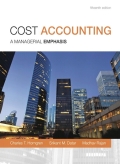
1.a
Revenue Budget:
The revenue budget is the budget prepared to estimate the revenue, the expected number of units to be produced and the expected selling price for each product. The revenue budget is the first step for an operating budget and the basis for the production and cost of goods sold budget.
To prepare: The revenue budget for March 2014.
1.b.
Production Budget:
The production budget refers to that budget which
To prepare: The production budget for March 2014.
1.c.
Direct Materials Usage Budget:
The direct materials usage budget is prepared to estimate the number of materials used in the production to produce a product. The budget shows the number of materials which are required to produce each finished unit, the beginning, and the ending inventory.
To prepare: The direct materials usage budget and the direct materials purchases budget.
1.d.
Direct Labor Budget:
The direct labor budget provides information about the total direct manufacturing labor hours and the cost of the total direct manufacturing labor hour.
To prepare: The direct manufacturing labor costs budget.
1.e.
To prepare: The manufacturing overhead costs budget.
1.f.
To prepare: The ending inventories budget for direct materials and for finished goods.
1.g.
Cost of Goods Sold Budget:
The cost of goods sold budget is the budget prepared to estimate the direct materials, labor and overhead for the coming financial period. This budget is the part of the operating budget.
To prepare: The cost of goods sold budget for March 2017.
2.
To explain: The two areas where continuous improvement can be incorporated.
Want to see the full answer?
Check out a sample textbook solution
Chapter 6 Solutions
Cost Accounting
- I need help with this financial accounting problem using accurate calculation methods.arrow_forwardCan you provide the valid approach to solving this financial accounting question with suitable standards?arrow_forwardEnron Enterprises made a lump sum purchase of land, buildings, and equipment.arrow_forward
- Solve this question by using appropriate.arrow_forwardAn asset's book value is $15,000 on December 31, Year 5. The asset has been depreciated at an annual rate of $3,000 using the straight-line method. Assuming the asset is sold on December 31, Year 5 for $12,000, the company should record: A. A loss on sale of $2,000. B. Neither a gain nor a loss is recognized in this type of transaction. C. A gain on sale of $2,000. D. A gain on sale of $3,000. E. A loss on sale of $3,000.arrow_forwardCalculate the net income to be reported by the company at the end of this month.arrow_forward

 AccountingAccountingISBN:9781337272094Author:WARREN, Carl S., Reeve, James M., Duchac, Jonathan E.Publisher:Cengage Learning,
AccountingAccountingISBN:9781337272094Author:WARREN, Carl S., Reeve, James M., Duchac, Jonathan E.Publisher:Cengage Learning, Accounting Information SystemsAccountingISBN:9781337619202Author:Hall, James A.Publisher:Cengage Learning,
Accounting Information SystemsAccountingISBN:9781337619202Author:Hall, James A.Publisher:Cengage Learning, Horngren's Cost Accounting: A Managerial Emphasis...AccountingISBN:9780134475585Author:Srikant M. Datar, Madhav V. RajanPublisher:PEARSON
Horngren's Cost Accounting: A Managerial Emphasis...AccountingISBN:9780134475585Author:Srikant M. Datar, Madhav V. RajanPublisher:PEARSON Intermediate AccountingAccountingISBN:9781259722660Author:J. David Spiceland, Mark W. Nelson, Wayne M ThomasPublisher:McGraw-Hill Education
Intermediate AccountingAccountingISBN:9781259722660Author:J. David Spiceland, Mark W. Nelson, Wayne M ThomasPublisher:McGraw-Hill Education Financial and Managerial AccountingAccountingISBN:9781259726705Author:John J Wild, Ken W. Shaw, Barbara Chiappetta Fundamental Accounting PrinciplesPublisher:McGraw-Hill Education
Financial and Managerial AccountingAccountingISBN:9781259726705Author:John J Wild, Ken W. Shaw, Barbara Chiappetta Fundamental Accounting PrinciplesPublisher:McGraw-Hill Education





